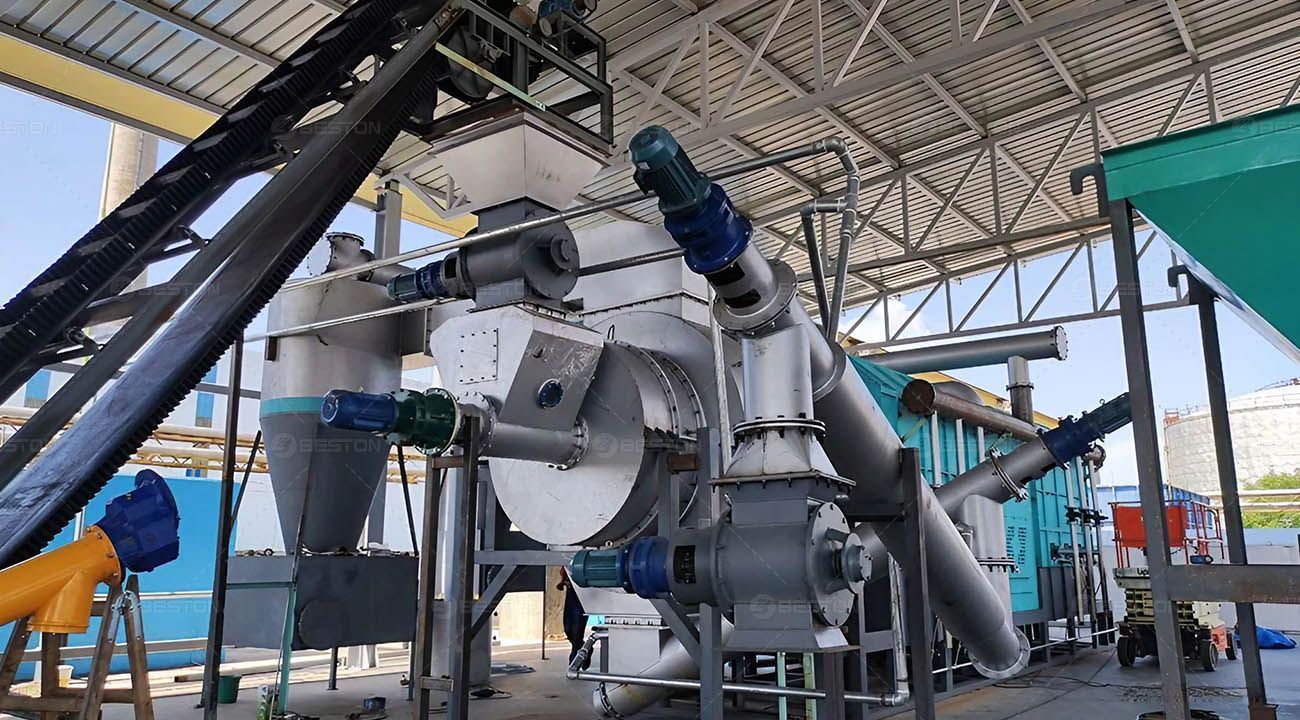Integrated Process Design of a Rice Hull Carbonizer System
The rice hull carbonizer represents a practical solution to transform agro-waste into high-value biochar through thermochemical conversion. Known for its high ash and silica content, rice hull requires controlled carbonization to ensure effective transformation and yield stability. The workflow of a carbonization system engineered for rice hull is built upon a modular yet continuous thermal processing framework.
Feedstock Preparation and Preconditioning
The process begins with feedstock conditioning. Rice hull, although dry in most post-milling environments, often exhibits non-uniform particle size and moisture content. A screening system removes oversized impurities such as small stones or grain remnants. If moisture exceeds 15%, a belt dryer or rotary drying drum is engaged to lower humidity to operational thresholds.
Stable moisture content ensures thermal efficiency and avoids incomplete pyrolysis or excessive smoke generation. Fine control in this phase enhances both throughput and downstream carbon quality of rice hull carbonizer.

Automated Feeding Mechanism
Dried rice hull is then conveyed via a screw or sealed belt system into a buffer silo. From this point, it is gradually introduced into the carbonization furnace using a frequency-controlled auger feeder. The feeding system must maintain an oxygen-limited environment to prevent premature combustion, ensuring the hull undergoes thermal decomposition rather than burning.
This sealed feed-in system plays a crucial role in maintaining process continuity and optimizing fuel-to-char conversion rates.
Primary Carbonization Chamber
The heart of the system is the carbonizer reactor—a horizontal cylindrical vessel, typically constructed from refractory-lined steel. Inside the chamber, rice hull is exposed to indirect heating in the temperature range of 350–600°C. The heat source can be biomass combustion, syngas recycling, or natural gas, depending on facility design.
Thermal decomposition occurs in an oxygen-deprived setting, breaking down volatile components and leaving behind fixed carbon. Volatile matter exits as a combustible gas mixture, while the remaining solid residue converts into porous biochar with high surface area.
Residence time and temperature gradients are adjusted via control panels and PLC systems, allowing operators to finetune the char structure for specific end-uses such as soil amendment or filtration.
Gas Recovery and Cleaning
The vaporized byproducts from the carbonization chamber are directed through a gas separator where char dust is removed. The remaining condensable gases, primarily tar, moisture, and light hydrocarbons, enter a condensation system. Water-cooled exchangers convert these vapors into liquid tar and aqueous byproducts.
The non-condensable gas—syngas—is stored in a buffer tank and partially recycled back into the burner for heat supply. This internal energy loop minimizes external fuel requirements and boosts system energy efficiency.
Emission control units, such as spray towers or activated carbon filters, treat residual off-gases to meet environmental discharge standards.
Char Discharge and Cooling
After the carbonization phase is completed, the hot biochar exits the reactor through a sealed discharge screw and is transferred to a water-cooling or air-cooling section. Proper cooling ensures safe handling and storage without the risk of spontaneous combustion.
The final product is collected in silos or packed for immediate sale, depending on processing flow. Optional pelletizing or grinding modules can be added to match market-specific specifications.
Control and Safety Systems
Advanced rice hull carbonizer systems integrate real-time control via programmable logic controllers. Thermocouples, oxygen sensors, and automated dampers are employed to regulate air flow, prevent backdraft, and adjust heating profiles dynamically. Emergency stop systems, pressure relief valves, and interlocked conveyors form part of the safety infrastructure.
Workflow Summary
- Pre-drying and screening – Ensures optimal moisture and purity
- Sealed feeding – Maintains inert conditions
- Carbonization reactor – Controlled thermal decomposition
- Gas condensation and recycling – Energy efficiency and tar separation
- Char discharge and cooling – Product stabilization
- PLC monitoring and safety management – Operational stability
The rice hull carbonizer operates as a continuous, low-emission system capable of converting voluminous agro-waste into industrial-grade biochar, while minimizing fuel consumption and labor intensity through integrated automation. Its workflow is a culmination of thermal engineering, process control, and environmental safety, providing a scalable path to biomass valorization.



